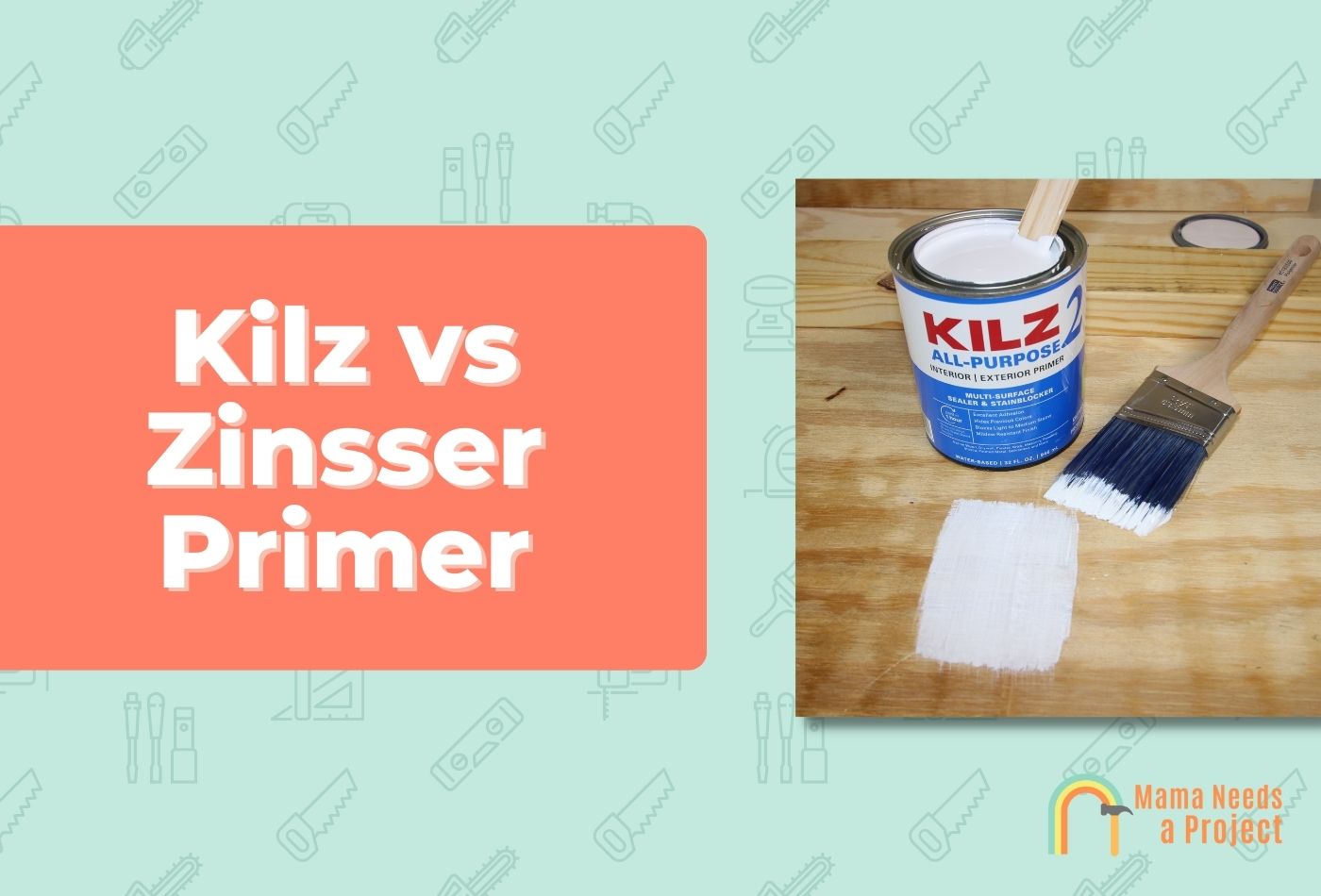Kilz vs Zinsser Primer: Which is Better? (2024 Comparison)
Applying paint primer is an essential part of just about every painting project, as primer strengthens paint and helps it adhere to surfaces.
But there are so many primers to choose form these days—how are you supposed to know which is best?
Kilz and Zinsser are two well-respected primer brands, and their products are often compared since they’re similar in quality and price.
Below, I’ll take a look at both primer brands to see which makes the best products and why. Let’s begin!
- Zinsser primer is an overall superior paint since it’s stronger, more receptive to paint, and better at preventing bleed-through and mold, yet it’s only a few dollars more than the Kilz mold-killing latex paint primer.
- The Kilz product is less odorous, quick-drying, easier-to-apply, and more versatile, but its inability to form exceptionally durable coatings means it’s inferior to Zinsser primer.
Kilz Primer vs Zinsser Primer
Adhesion
Kilz primer and Zinsser primer both adhere well to surfaces, and both are very receptive to paint.
That said, because Zinsser primer essentially forms a new, flawless layer on which paint can be applied, it offers better adhesion than the Kilz product.
Kilz primer seeps into the wood’s pores, which is fine if you’re working with a totally bare wooden surface, but not when you’re painting to cover up stains, faded paint, etc.
If too much primer seeps into the pores and mixes with whatever is already in them, the result could be a blotchy mess that’ll have to be redone.
And even on a bare surface, you’d need a few layers of Kilz primer to ensure decent adhesion, whereas one layer of Zinsser primer would probably be fine.
Note: Adhesion is important whether we’re talking about indoor or outdoor surfaces, but it’s especially important for outdoor surfaces since these are regularly subjected to the elements.
Durability
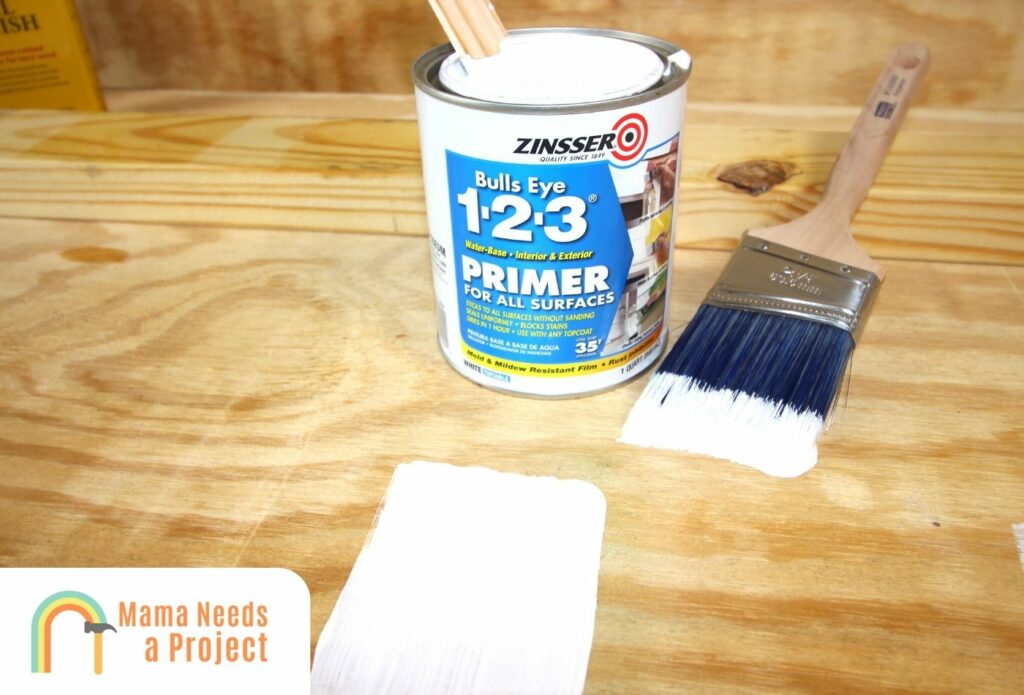
When it comes to durability, Zinsser primer has Kilz primer beat, in large part because it’s a thicker primer that’s formulated to withstand errosive factors and last a long time.
But this doesn’t mean Kilz isn’t a durable primer; it’s just that Zinsser is slightly more durable.
Therefore, Zinsser primer is a good primer for exterior surfaces, since it’ll hold up even after being exposed to the elements for a prolonged period.
Durability is an important quality to consider when shopping for paint primers, since the more durable a primer is, the more likely it is the paint will adhere to it for a long time.
Generally speaking, oil-based primers are more durable than latex primers, mainly because the components in oil-based primers collectively make them thicker and harder to wear down.
That said, if you apply 2-3 layers of a water-based primer, you could get the same durability as one layer of oil-based primer affords, but this isn’t always the case.
Ease of Application
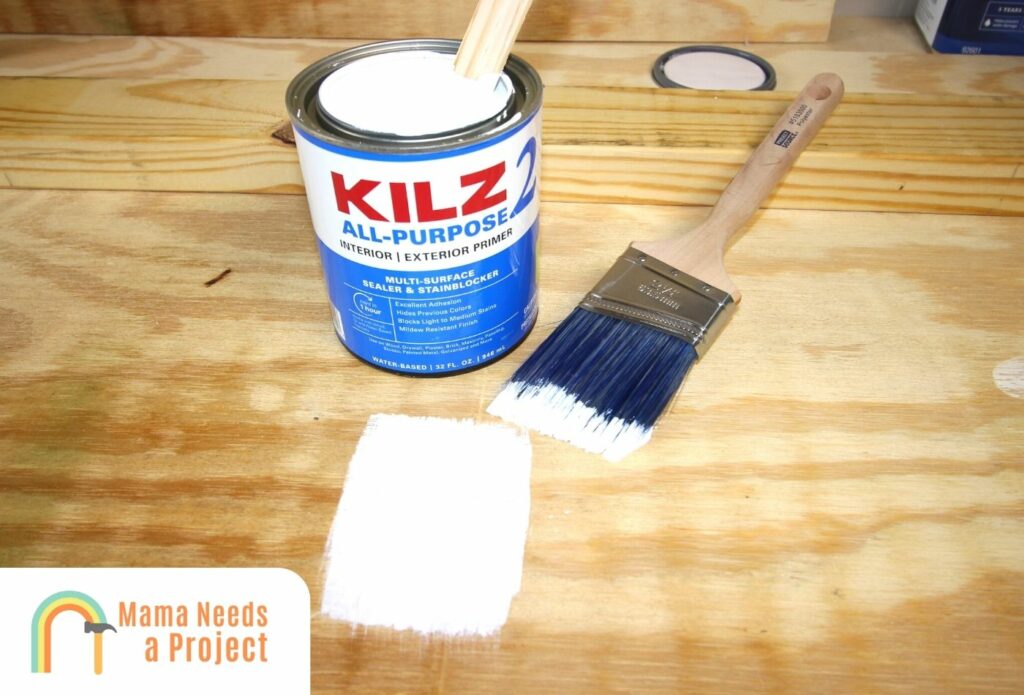
Water-based primers are easier to apply than their oil-based counterparts, so in this category Kilz water-based primer is superior.
Water-based products are easier to apply because they’re much thinner.
You can apply this kind of primer with a brush, roller, cloth, or sprayer, but the fastest applicator by far is the sprayer; technically oil-based primers can be sprayed too but their thickness often causes the sprayer to not work properly.
The only thing that can make applying water-based primer tedious is the need for multiple layers. Sometimes one will do, but usually you need multiple.
That said, since this primer dries quickly, even applying multiple coats is almost always an easier task than putting down just one layer of thick, oil-based primer.
Drying Time
Water-based paint primers dry much quicker than oil-based primers because they’re not as viscous.
Specifically, it takes just 30 minutes for most latex primers to dry all the way through.
Therefore, most Kilz primers will be completely dry hours before an oil-based primer will reach this state; I say most because there is a notable exception.
Kilz Original primer, an oil-based primer, can take anywhere from five to seven hours to dry completely, but it’s best to let this primer dry for at least 24 hours.
Of course, the same can be said for Zinsser primer, since it’s oil-based and employs many of the components Original Kilz primer possesses.
Odor
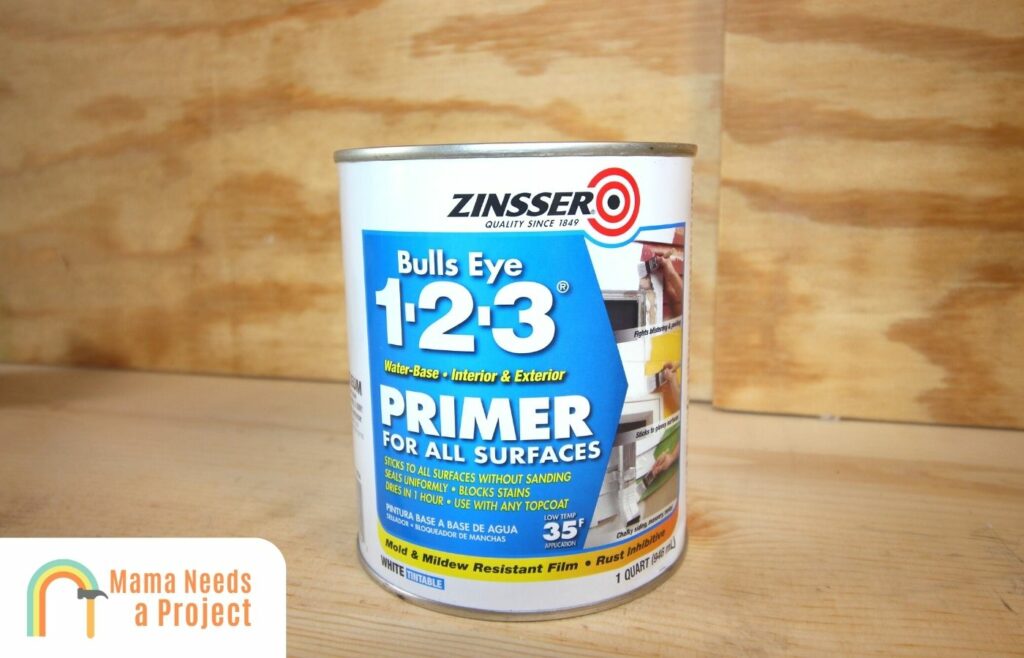
The odor a primer emits may not seem like a big deal at first, but did you know that a primer’s odor is directly linked to its toxicity?
Essentially, the chemicals and volatile organic compounds (VOC) in primers are what cause the distinct odors.
Therefore, the stronger the odor, the more likely it is the product is highly toxic.
Zinsser primer emits a much stronger odor than Kilz primer, mainly because it’s oil-based.
But make no mistake: water-based primers like those made by Kilz emit odors too, as they too contain toxic chemicals and VOC, but these odors are far less harsh, indicating latex primers are much less toxic.
Bleed-Through
When you’re applying primer over old paint, stains, etc., you don’t want any of the old finish bleeding through.
If this happens, the final surface can look blotchy, and chances are it’ll be uneven.
Zinsser paint primer technically prevents bleed-through better than Kilz primer because it’s thicker, but both products do well in this regard.
The thing about Kilz primer is it’s 100% opaque when applied, but as it dries it loses some of this opaqueness, which is why especially prevalent marks, stains, etc. underneath are able to show through.
This doesn’t happen with Zinsser primers since they’re viscous and don’t seep into porous surfaces.
Check out these top rated primers for plywood to get the best results for your project!
Mold Resistance
One of the main reasons why paint primer is used is to prevent mold growth.
Paint that doesn’t adhere well to a surface is especially prone to mold growth, and once mold starts growing the paint isn’t the only thing you should be concerned about—it can also reduce the soundness of the surface underneath the paint.
Kilz primer and Zinsser primer are both good at preventing mold growth, so in this category it’s a tie.
These primers also ensure protection from mildew and other erosive elements.
It’s been said that primers with a thicker consistency, i.e. oil-based products, offer more protection from mold and mildew, but I know of latex-based products that provide just as much protection, if not more, despite being thinner.
Rust Resistance
Just as a paint primer has to resist mold, it has to resist rust as well, especially if it’s being applied to a metal surface.
By resist, I mean it has to adequately cover up rust so this doesn’t negatively affect the paint.
The best paint primers don’t just resist rust—they prevent it from forming in the first place by keeping the surface underneath protected.
Zinsser paint primer is without a doubt the best primer for rust inhibition thanks to its engineered formula.
Kilz premium primer provides decent protection from rust too, but this protection erodes rather quickly, whereas Zinsser primer will stay rust-resistant for multiple years.
Price
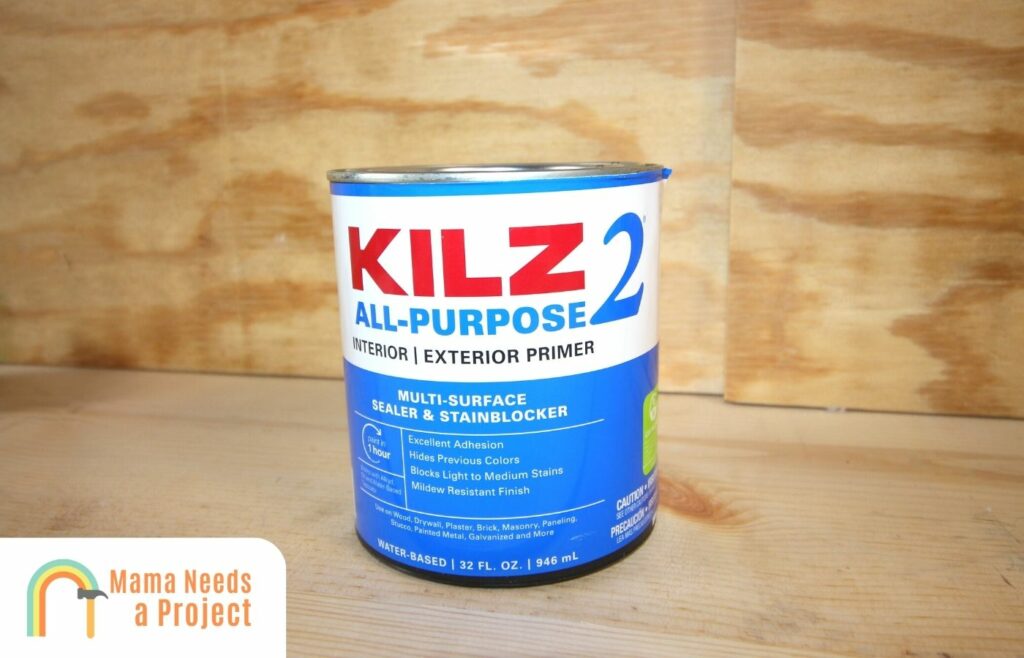
As far as price goes, Zinsser primers are a little more expensive than Kilz primers, and when I say “a little” I mean Zinsser products are usually just $2-3 more than Kilz products.
But just because Zinsser primers are superior to Kilz primers in several respects doesn’t mean they’re ideal for every instance.
For example, there are times when you won’t need such a thicker primer, and in these instances Kilz primers are ideal.
But when considering price, you also need to consider longevity, since a product that holds up for many years is going to get you more bang for your buck.
Sanding
Both primers are easy to sand, so this is another category where it’s a tie.
Kilz primer is easy to sand because it’s thinner, Zinsser is easy to sand because of its composition.
Sanding paint primer before applying paint is absolutely necessary, as sanding helps paint adhere to the primer (and surface) better.
Note: Just be careful not to sand off too much of the primer, as doing so may cause the paint coats to be blotchy or uneven.
Selection
Both brands make a range of paint primers, so if you like Kilz latex primer because it’s quality chances are you’ll like their oil-based product.
The size of a brand’s selection isn’t the most important factor, but it’s relevant to address here since many consumers practice brand loyalty.
Kilz vs Zinsser for Cabinets
Kilz and Zinsser paint primers can be used on all kinds of cabinets, whether they’re in the kitchen, bathroom, or garage.
But when it comes to garage cabinets, you may want to go with a more durable Zinsser primer, since their products can withstand the elements better.
What really matters is the kind of wood the cabinets are made of. If it’s more receptive to water-based primer, go with this. Again, some woods don’t take oil-based primers, particularly softwoods that are moister and boasting lighter shades.
Kilz vs Zinsser for Pet Urine
Paint primer is often used to cover up stains, not only visually but smell-wise too.
Pet urine can leave some pretty stubborn stains, and it has a distinct, unpleasant smell, but thankfully both paint primers can cover up the stains and the smell.
You may not have a big problem if your pet urinated on hardwood, since these woods aren’t that porous.
But if they urinated on something softer like pine, spruce, or ash, eliminating the smell with paint primer will be more challenging, especially if the urine has had time to set in the wood pores.
Before applying the primer, it’s best to throughly clean the surface so you can remove as much of the smell as possible before the primer seals it off for good.
It’s best to address this problem right away once you identify it, as wood that’s been made moist by urine is a prime location for mold to flourish—yuck!
Kilz vs Zinsser for Kitchens
Since the temperature can get quite high in the kitchen when you’re cooking, and since water can get splashed around at times, using a durable primer makes sense.
But again, the cabinet wood is the most important factor to consider when you’re deciding which paint primer to use, regardless of where the cabinets are mounted.
Therefore, if you have softwood cabinets in the kitchen because their light shades go well with the surrounding decor, it’s best to stay away from oil-based paint primers, as these can discolor the wood and negatively affect the topcoat.
But if you’ve got hardwood oak cabinets, for example, in your kitchen, you shouldn’t have any problems with discoloration, even if you use an oil-based finish.
Kilz vs Zinsser for Bathrooms
Both primers can be used in bathrooms to great effect.
Here too, the temperature can get high, but you’ll also have to consider steam production.
These factors make Zinsser primers seem like the best option right away, but the truth is both Zinsser and Kilz primers can hold up well in the hottest and steamiest of bathrooms.
And both primers ensure top-quality mold resistance, which is integral in bathrooms considering there’s usually a decent amount of moisture in the air.
Primer adhesion is also critical, since without this the paint would just peel off in no time at all.
What are Primers Used For?
Better Paint Adhesion
Primer is usually applied to surfaces before paint, mainly so the paint can adhere to the surface better and last a long time. Primer also strengthens paint.
Sure, you could apply paint directly to a wood or metal surface, but chances are it’ll peel, chip, or crack faster if you do.
Plus, thanks to primer, paint can be applied to surfaces that are otherwise unreceptive to paint.
Usually one coat of primer is enough to ensure decent paint adhesion, but if you want to be on the safe side you can use 2-3 coats.
Reduce Mold Growth
Mold thrives in damp area that don’t get a lot of sunlight. Therefore, wood in such areas needs primer, as this can help the wood fight off mold growth and the damage it causes.
Most primers designed for exterior surfaces have components that ensure mold resistance, and you can even use these primers on interior surfaces for the same reason.
Generally speaking, primers that are strong enough to eliminate mold can also totally cover up tough stains, hairline cracks, nail holes, etc.
Preventing Bleed-Through
If you’re painting over a surface that already has paint on it, primer is essential.
But the primer must be able to prevent bleed-through, otherwise the old paint may show through the new coat, especially if it’s on the darker side. This is why it’s so essential to paint over Kilz and any primer.
Generic primers are good at covering up minor flaws, but if covering stubborn stains is your mission then you’ll need either of the products discussed here.
Final Thoughts
All things considered, Zinsser paint primer is generally superior to Kilz primer, but in many ways these products are similar.
Basically, if you want a stronger, thicker primer that prevents stains, smells, and surface defects from showing through a brand new coat of paint, choose a Zinsser mold-killing primer.
On the other hand, if you want a less-toxic, quick-drying, water-based primer that’s fully capable of achieving good results but isn’t as strong as oil-based primers, go with Kilz premium later paint primer.

